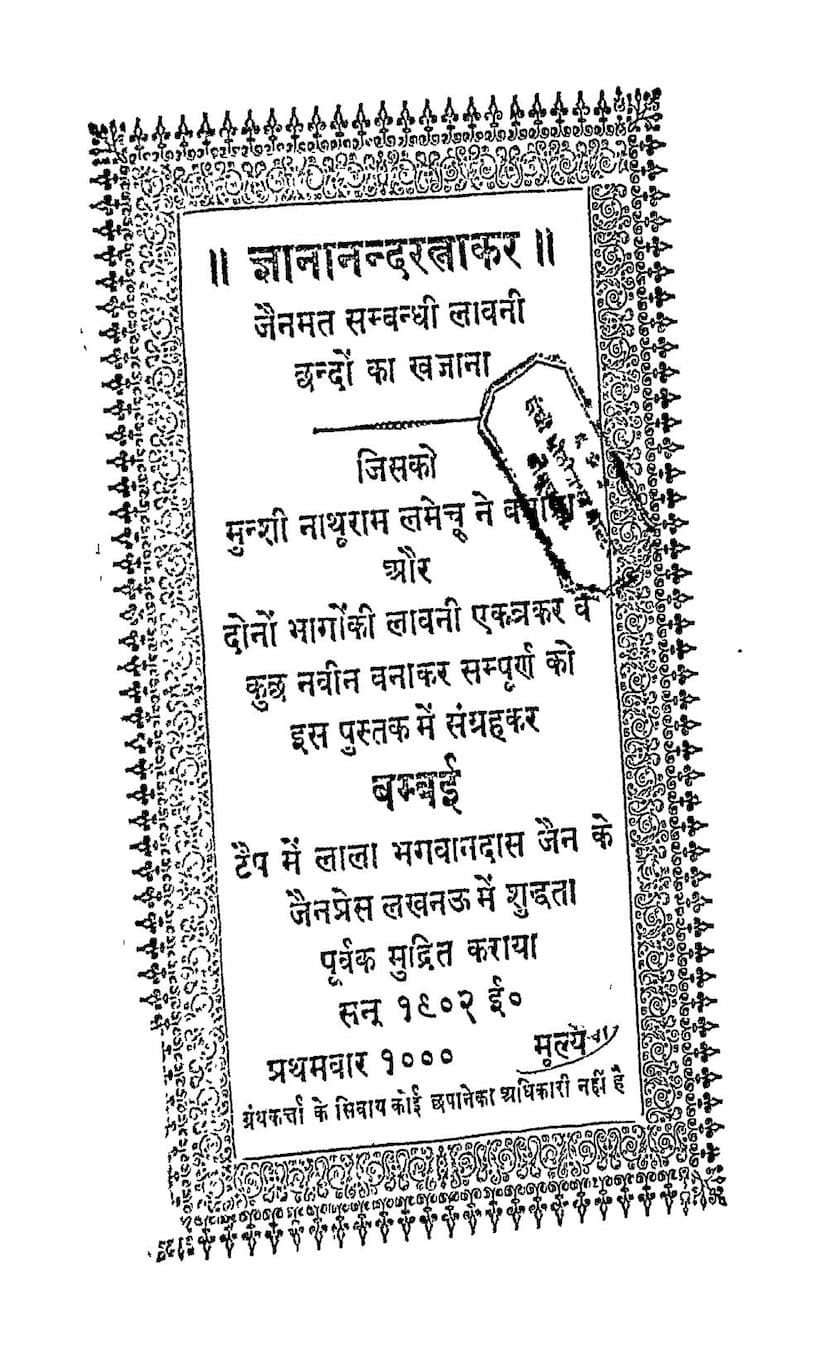Gyanand Ratnakar
Added to library: September 1, 2025

Summary
This document is a comprehensive Jain text titled "Gyanand Ratnakar" (ज्ञानानन्दरत्नाकर), compiled by Nathuram Munshi and published by Lala Bhagvandas Jain. The catalog link provided is https://jainqq.org/explore/010697/1.
The text is a collection of devotional songs (lavani chhand) and teachings related to Jainism. It appears to be a significant work, as it is mentioned that both parts of the lavani were combined, some new ones were added, and the entire work was compiled and printed at the Jain Press in Lucknow.
The book begins with prayers and salutations to Jain Tirthankaras, starting with Adinath (Adishwar), followed by other Tirthankaras, each invoked with specific virtues and blessings.
The "Gyanand Ratnakar" covers a wide range of Jain philosophical and devotional themes, presented in the form of "lavani" (a lyrical poetic form). Key sections and themes include:
- Praise of Tirthankaras: The early pages extensively praise the virtues and powers of various Tirthankaras, starting from Adinath and going through the twenty-four Tirthankaras. The author invokes them for liberation, knowledge, and overcoming obstacles.
- Praise of Jin Pratima (Idol of Jina): A significant section is dedicated to the veneration of Jain idols, emphasizing their sanctity and the spiritual benefit derived from worshipping them. It contrasts the pure form of Jain idols with worldly attractions and criticisms.
- Critique of Kaliyuga: The text addresses the perceived decline in spiritual values during the Kaliyuga (the current era), criticizing hypocrisy, the misinterpretation of scriptures, and the deviation from Jain principles by some individuals. It also touches upon perceived distortions in other religious traditions.
- Praise of Gurus: The importance and virtues of Jain gurus are highlighted, emphasizing their role in guiding disciples towards spiritual liberation through their renunciations and selfless service.
- Prohibition of Gambling (Jua Nishedh): A strong condemnation of gambling is presented, detailing its negative consequences on individuals, families, and society, including ruin, theft, and moral degradation.
- Criticism of Krishna and other figures: The text critiques certain narratives associated with Krishna and other figures from the Hindu pantheon, interpreting them in a way that aligns with Jain principles, often highlighting perceived moral failings or misinterpretations.
- Praise of Digambara posture: Several sections extol the virtues and spiritual significance of the "Param Digambar" (absolute naked) posture of Jain Tirthankaras, viewing it as a symbol of complete detachment and spiritual purity.
- Devotional Songs (Lavani): The bulk of the book consists of these lyrical compositions, covering various aspects of Jainism, including:
- Praise of Jinendra: Invoking the Tirthankaras for protection and spiritual guidance.
- Praise of Param Digambar Mudra: Glorifying the significance of the naked asceticism.
- Merits of Darshan (Seeing the Tirthankara): The spiritual benefits of having the vision of Tirthankaras.
- Chausathki Lavani: Discussing the cycle of births and the path to liberation.
- Viharman Vees Tirthankara: Praising the Tirthankaras who are still alive and actively spreading Jain teachings.
- Siddhon ke Swarup: Describing the nature and state of liberated souls (Siddhas).
- Hitopadesh: Offering moral and spiritual advice.
- Kumatiki Lavani & Sumati ki Lavani: Contrasting the negative path of ignorance (Kumati) with the positive path of wisdom (Sumati).
- Kumatiki Chetan ka Jagda: A narrative depicting a conflict between ignorance and wisdom.
- Vavaji ki Lavani: Differentiating between true renunciation (Vairagi) and mere outward show (Vavaji).
- Panch Namokar ki Lavani: Explaining the significance of the five supreme beings invoked in the Namokar Mantra.
- Vishnu Kumar Charitra: A narrative detailing the story of Vishnu Kumar, a Jain saint.
- Tirthankaron ke Gunon ki Lavani: Praising the qualities of the Tirthankaras.
- Bhart ki Lavani: The story of Bharat, a righteous king.
- Harda ke Mandir ki Atishay: Miraculous events associated with a temple in Harda.
- Jind Darshan ki Lavani: The importance of seeing the Tirthankaras.
- Jain Bhajan ka Updesh: Instructions on the practice of Jain devotion.
- Ravan ko Updesh: Advice given to Ravana.
- Tote ki Lavani: A parable of a parrot.
- Ravan Mandori Samvad: A dialogue between Ravana and his wife Mandodari.
- Sita Haran ki Lavani: The story of Sita's abduction.
- Rakshas Vanshiyon ki Utpatti: The origin of the Rakshasa lineage.
- Vanar Vanshiyon ki Utpatti: The origin of the Vanara (Monkey) lineage.
- Triya Janm ki Ninda: A critical perspective on the female birth in Jainism, highlighting the difficulties and suffering often associated with it.
- Mukh Jain ki Lavani: Criticizing those who claim to be Jain but deviate from the true path.
- Kutil Dhongi Bhavak ki Lavani: Condemning hypocrisy and false devotion.
- Jinesh Stuti: Praises of Jinendra.
- Bhavya Prashansa: Praising those who follow the spiritual path.
- Jind Bhajan ka Updesh: Further emphasis on the importance of devotional singing.
- Rishabhdev Stuti: Praises of Adinath.
- Parasnath ki Stuti: Praises of Parshvanath.
- Choubees Tirthankaron ke Chinh: The symbols associated with the twenty-four Tirthankaras.
- Ganesh ki Vyakhya: Explaining the significance of Ganesha in relation to Jain traditions.
The author, Nathuram Munshi, states that he has compiled and added new compositions to this extensive collection. The book was printed in 1902 CE. It is a rich resource for understanding Jain devotional literature and the philosophical underpinnings of Jainism as expressed through lyrical poetry.